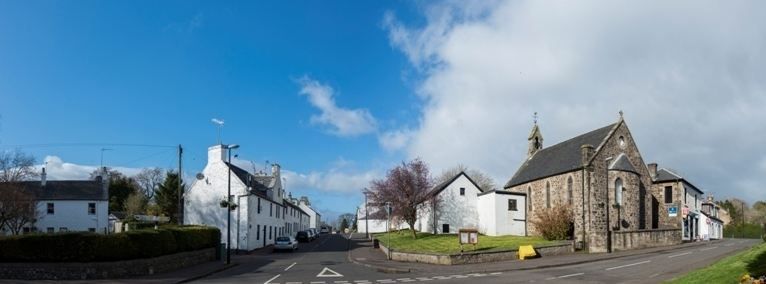This month, an upgrade was launched for Understanding Scottish Places (USP), the online tool which allows anyone to access valuable, user-friendly data on Scotland’s towns. For communities and towns practitioners, USP aims to help inform better decision-making and to inspire discussion. Indeed, there is a strong case for improving access to higher quality data to take strategic decisions and more targeted approaches, as highlighted by the Carnegie UK Trust, a USP funding partner.
Since its launch in 2015, USP has proved very popular with the website being used over 10,000 times. The tool has also been used as the basis for over 20 in-depth USP Your Town Audits where further information on a place’s function and performance is gathered through carrying out practical surveys. Additionally, USP has also been used as a foundation for wider programmes such as the Federation of Small Businesses Initiative to find Scotland’s most entrepreneurial places.

Ullapool, one of Scotland’s most entrepreneurial towns, according to FSB study based on Understanding Scotland’s Places data
The newly upgraded USP comprises several new features, including data on individual towns’ retail offer, commuter flows and amount of grant funding secured. It is hoped that these new features will enable USP to further assist the development and regeneration of Scotland’s towns.
This article provides a brief look at why USP was originally launched and the useful data which it offers.
Why was USP launched in 2015?
In 2012, the Scottish Government commissioned the National Review of Town Centres to identify the key issues facing our towns and to address these through a measured, long-term approach to their regeneration. To guide this Review, an External Advisory Group was brought together. With a particular focus on enhancing community, enterprise and place within towns, this cross-sector Group provided several recommendations for town leaders to improve their strategies.
One of these recommendations highlighted ‘the need for action’ – in other words, how we can enable and deliver change in our towns. To drive this, the Group recognised the vital importance of gaining a clear view of the ‘health’ of town centres and therefore proposed a demonstration project to illustrate how data could be gathered and shared.
In late 2013, the Scottish Government responded to the Review through the publication of The Town Centre Action Plan. In particular, the Government endorsed the need to enhance knowledge of the health and performance of towns and thus set out a short-term action for data to be gathered on town centres.
This led to the commissioning of Understanding Scottish Places by the Scottish Government and its subsequent launch in April 2015. Together with the Carnegie UK Trust, the Government has funded its development with support from a consortium including Scotland’s Towns Partnership (STP), the Centre for Local Economic Strategies (CLES) and the University of Stirling.
What information does USP provide?
USP was established as the first platform to provide valuable data specifically on the 479 settlements in Scotland which have a population of greater than 1000 residents. This includes places on the edge of conurbations which demonstrate their own town identity such as Ratho in Edinburgh and Carmunock in Glasgow.

Curmunnock in Glasgow, recognised for its own town identity in USP.
In contrast to other locality level measures, such as the Scottish Index of Multiple Deprivation, USP does not present the town data in ranks as this may give rise to simplistic comparisons. This forms part of the original intention of USP, as highlighted by Professor Leigh Sparks, “to challenge some existing perceptions of places”.
Instead of ranking, USP permits users to identify shared characteristics and make comparisons between any of the 479 towns on:
- Household information (newly upgraded USP includes ‘Population change’);
- Demographic variables (newly upgraded USP includes ‘Changes in the number of jobs’);
- Socio-economic variables (newly upgraded USP includes ‘Amount of Grant Funding’ and ‘Number of Tourist Beds’).
Additionally, the tool also categories places by locality size, in line with the Scottish Government’s 3 fold Urban Rural Classification. Town size is included due to its important role in determining a place’s ability to operate and provide services.
USP also offers an inter-relationship model where users can look at the level of dependence, independence or interdependence of a town to its neighbouring settlements. This model is grounded in research undertaken by the Centre for Local Economic Strategies (CLES) which examined assets and relationships in different sectors within a place and how these can affect economic resilience. Building on this work, the inter-relationship model for USP scores each place against a number of indicators which measure its dependency on neighbouring places for these assets and relationships. These indicators include:
- The number of certain assets relative to population (including registered charities, hospitals and schools);
- The diversity of the business and employment base in the town (newly upgraded USP includes the percentage of retail types from a typology of 37 classes);
- The distance that residents travel to work and to study.
As explained by CLES in a recent press release, by using this inter-relationship model, it enables a town’s economic strategy to be rooted in the place itself and not simply to conform to traditional practices.

Commuter Flow Map for Perth from USP
In addition, as a new feature for 2017, USP can now provide an insight into major and minor commuter patterns from a place through the new ‘Commuter Flow Map’. Moreover, each town profile provides a short summary of the town’s unique history, geography and economy.
For further information on the sources and analysis of all of the above datasets, follow the link here.
Understanding Scottish Places: Future Developments
Going forward, the consortium behind Understanding Scottish Places is encouraging individuals to test the tool and submit suggestions for further improvements to Scotland’s Towns Partnership at: ewan@scotlandstowns.org. This is in advance of a further upgrade which is anticipated for release later this year.
Additionally, the consortium would also welcome support from data providers and partners to further enhance this valuable data platform.
